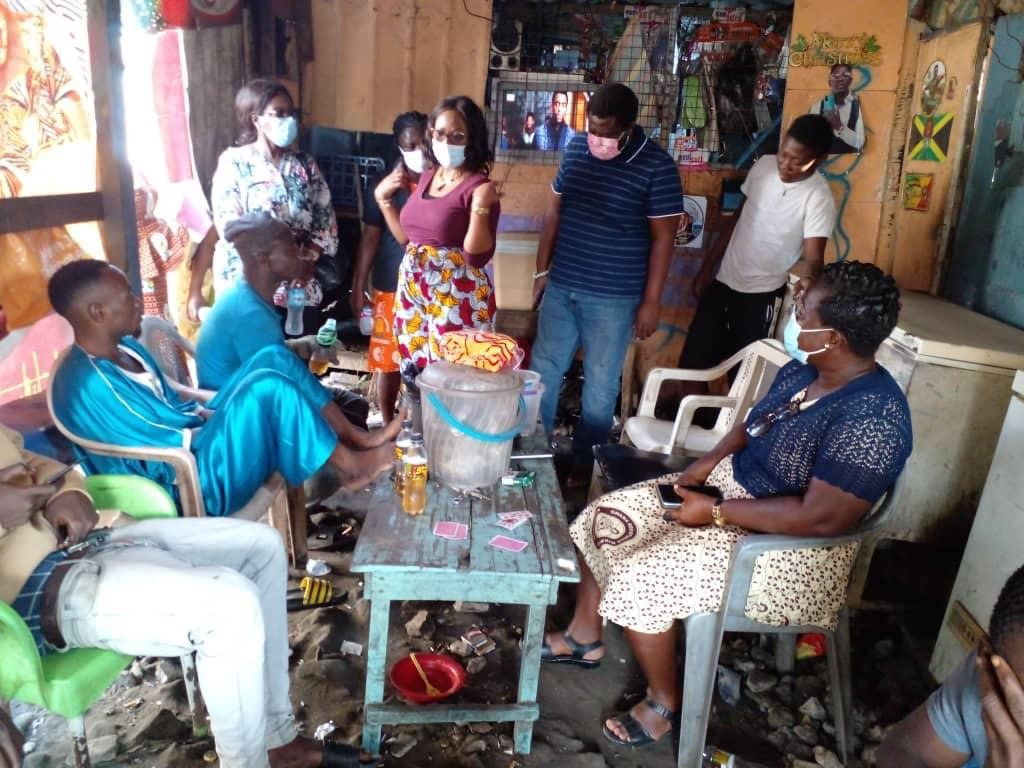
Covid & Cities Blog – 6th in the Series: What role did local governments in Accra play in the response to Covid-19?
Nana Efua E. Afun & Lauren J. Wallace
Image shows COVID-19 community education and sensitization with elders in Ashaiman municipality, Greater Accra.
Background
In Ghana, there are clear structures for the management of public health emergencies at all levels of government. There is a particular emphasis on coordination and communication between the various levels of government to ensure a rapid and effective response. As urbanization continues to increase globally, local-level (city) governments, in particular, play an important role in responding to complex challenges such as health emergencies.[i],[ii] Good coordination between both actors at city level and between cities and national governments is especially significant when addressing health emergencies as it assists in avoiding conflicts and confusion and ensures the effective and efficient use of limited resources.[iii]
With the emergence of COVID-19, the government of Ghana introduced the National Strategic COVID-19 Response Plan with an emphasis on a balanced centralised and decentralised response.[iv] Focusing on two municipalities in Greater Accra, we delve into the coordination of the response to the first wave of COVID-19 by local governments, the barriers to effective local governance of the pandemic, and ways forward.
Methods
We drew on desk review of official documents and media reports published from March 2020 to September 2020 and in-depth interviews conducted in February and March of 2021. Documents were sourced from Factiva, Google and organisational websites. In-depth interview respondents were from the municipal health management teams and municipal assemblies involved in key areas of the response.
The National Government’s Role
The national government was responsible for setting public health guidelines, issuing directives, training, and providing funds, infrastructure, and logistics. In addition to overseeing case management, surveillance, and directives to enhance mask wearing, social distancing, and hygiene, the government of Ghana introduced numerous measures to mitigate the negative social and economic impacts of the COVID-19 pandemic. The national government’s response included (but was not limited to) the following:
- A 3-week partial lockdown (28 Mar-2020 to 19th April 2020) of selected districts in Greater Accra and Kumasi
- Free treatment and isolation for covid-affected persons
- Mass disinfection exercises in public places
- The absorption of water and electricity bills for lifeline consumers, and mobilisation of water tankers to supply water to vulnerable communities
- A soft loan scheme for small and medium scale businesses
- Individual grants and loans for covid-affected vulnerable persons
- Provision of food packages to vulnerable persons
The Roles of the Local Government
In Ghana, the responses of local government seemed to primarily focus on implementing interventions in the national COVID-19 response plan. Local governments played an essential role in the response to the pandemic.
Roles of the assembly and the health directorate
Municipal Health Management Teams (MHMTs) and municipal/district assemblies were both lead agencies in the response and worked in close collaboration with one another. A primary role of Municipal Assemblies was to convene Public Health Emergency Management Committees, which are multisectoral structures to coordinate preparedness and response to the pandemic within their municipality. MHMTs had two primary roles: first they acted as the primary source of information about COVID-19 in the municipality. Second the MHMT oversaw surveillance and case management in the municipality.
Risk communication and other preventive protocols
Municipal assemblies, together with MHMTs, coordinated public education about COVID-19 through the National Commission for Civic Education. Their strategies included training assembly members, representatives of faith-based organisations and NGOs, opinion leaders, health facilities, and business organisations. These members in turn, educated their communities, staff, members and clients on the COVID-19 protocols. Together with market associations, traditional and relevant authorities, assemblies also decongested markets. While some assemblies closed the main markets and created smaller markets for social distancing purposes, others employed a shift system.
Case management and surveillance
MHMTs convened and directed municipal case management teams, and municipal Rapid Response Teams which are technical, multidisciplinary teams that are responsible (respectively) for coordinating case management and surveillance.
Assemblies facilitated a number of case management and surveillance activities, including assisting the central government and MHMTs to set up treatment and isolation centres, and distributing PPE to health facilities. Assembly members were also involved in mobilising their communities for COVID-19 testing and assisting contact tracers to locate the contacts of positive cases.
Relief programs for the most vulnerable and needy
Assemblies collaborated with relevant national agencies and ministries to implement relief programs. For instance, the local government distributed dry and cooked food to vulnerable persons, in collaboration with the National Disaster Management Organisation (NADMO), the Ministry of Gender and Social Protection, and Faith Based Organisations. They also coordinated the registration of businesses for grants and loans, in collaboration with the National Board for Small Scale Industries (NBSSI).
Assemblies ensured the absorption of water bills, and the mobilisation of water tankers to supply water to vulnerable communities. Assemblies also received funds from the national level to construct water sources; including mechanised boreholes and polytanks.
Barriers to an Effective Covid-19 Response at the Local Level
Inadequate resources, less-than-optimal engagement of communities, and an arbitrary and biased selection of beneficiaries of relief, were three major challenges faced by local governments which marred their effectiveness.
Inadequate resources, including funds and logistics, was a major challenge which cut across all aspects of the response. For example, inadequate funds and vehicles for health promotion made it difficult to carry out extensive and frequent educational activities in communities. Inadequate coordination between district health directorates and municipal assemblies, particularly for risk communication, may have reduced the efficiency of the limited resources available.
Assembly members, who are a main point of contact with the community, were not involved in some public health activities and relief interventions. In one municipality, market decongestion was perceived to be poorly executed, since assembly members were not involved in the planning process, and the public were insufficiently educated about the intervention.
There were reports of political interference in implementing some interventions. The politicisation of relief items was perhaps most evident in the distribution of food relief, in which politically exposed persons were in charge while other relevant leaders such as assembly members were less involved. In this case, it was perceived that the distribution process was biased and was influenced by political affiliation with the ruling government.
Way Forward
The government of Ghana’s commitment to a ‘whole of government’ and ‘whole society approach’ to addressing the COVID-19 pandemic, particularly the clear directives, guidelines and roles given to local governments, were laudable. However, the national measures put in place may not have had the desired effect due to challenges faced in implementation, which included: gaps in coordination within local governments, inadequate resources –including logistical and financial challenges that impacted case management and risk communication, and finally, less-than-optimal engagement of communities and an arbitrary and biased selection of beneficiaries in the distribution of relief. It is also crucial that more effective mechanisms/sources for financing public health emergencies be sought at all levels, and that the functionality of existing mechanisms for multisectoral coordination of local government actors, such as Public Health Emergency Management Committees, be ensured. In addition we recommend that a transparent, bottom-up and community-led approach be adopted in the implementation of relief interventions.
This blog is based on joint research undertaken through a collaboration between the COVID-19 in West and Central African Health Systems (CATALYSE) and Community-led Responsive and Effective Urban Health Systems (CHORUS) projects. CHORUS is a research programme consortium funded by the UK’s Foreign, Commonwealth and Development Office focusing on urban health systems in four countries. The CATALYSE project, funded by International Development Research Centre grant no. 109479, focuses on policy and systems responses to COVID-19 in West and Central Africa.
Author Bios
 Mrs. Nana Efua Enyimayew Afun is a bilingual researcher at WAHPSCon, the West and Central African Health Policy and Systems Consortium, hosted at the Dodowa Health Research Centre. She worked on the CATALYSE (Covid-19 in West and Central Africa) Project and the ADOWA 2 (Gender Responsive Health Systems for Adolescents) Project, amongst others.
Mrs. Nana Efua Enyimayew Afun is a bilingual researcher at WAHPSCon, the West and Central African Health Policy and Systems Consortium, hosted at the Dodowa Health Research Centre. She worked on the CATALYSE (Covid-19 in West and Central Africa) Project and the ADOWA 2 (Gender Responsive Health Systems for Adolescents) Project, amongst others.

Lauren J. Wallace is a medical anthropologist whose research critically examines the making and implementation of health policies at national and sub-national levels in West Africa. She is a Senior Researcher at the West and Central African Health Policy and Systems Consortium, at the Dodowa Health Research Centre (Research and Development Division, Ghana Health Service). Dr. Wallace was the Ghana Principal Investigator of the IDRC-funded study Covid-19 in West and Central African Health Systems (CATALYSE) study, and a co-investigator on the IDRC-funded study Gender Transformative and Responsive Health Systems for Adolescents. She is a qualitative researcher for CHORUS Ghana.
References
[i] Sharifi, A. & Khavarian-Garmsir, A.R. The COVID-19 pandemic: Impacts on cities and major lessons for urban planning, design, and management. Sci Total Environ. 2020;749: 142391.
[ii] Elsey H, Agyepong I, Huque R, Quayyem Z, Baral S, Ebenso B, et al. Rethinking health systems in the context of urbanisation: Challenges from four rapidly urbanising low-income and middle-income countries. BMJ Glob Health. 2019;4:e001501.
[iii] Connolly C, Ali SH, Keil R. On the relationships between COVID-19 and extended urbanization. Dial Hum Geogr. 2002; 10(2):213–216.
[iv] Ministry of Health, Ghana. Ghana National Strategic COVID19 Response Plan: July 2020-Dec 2021. Accra. c2020.